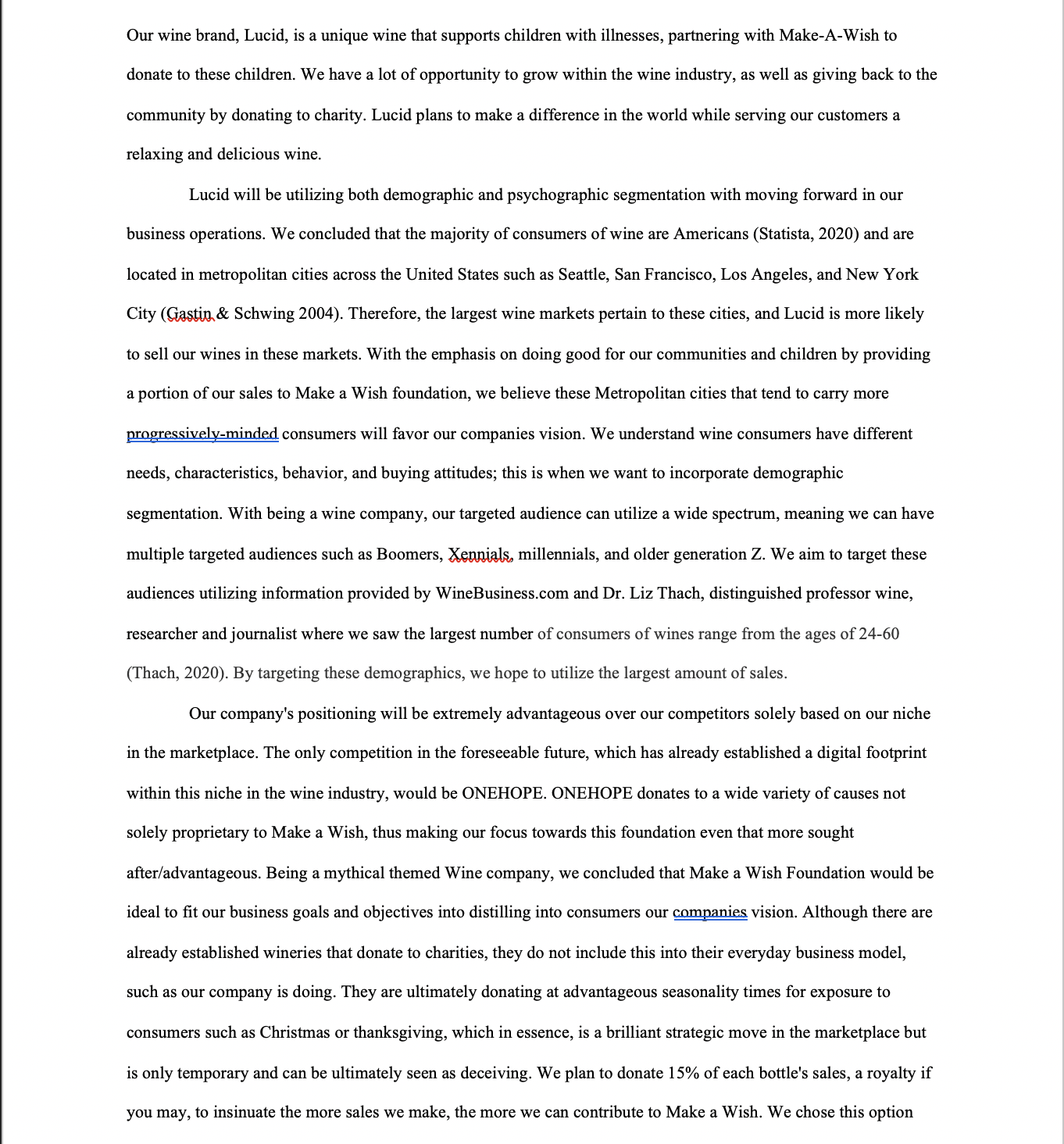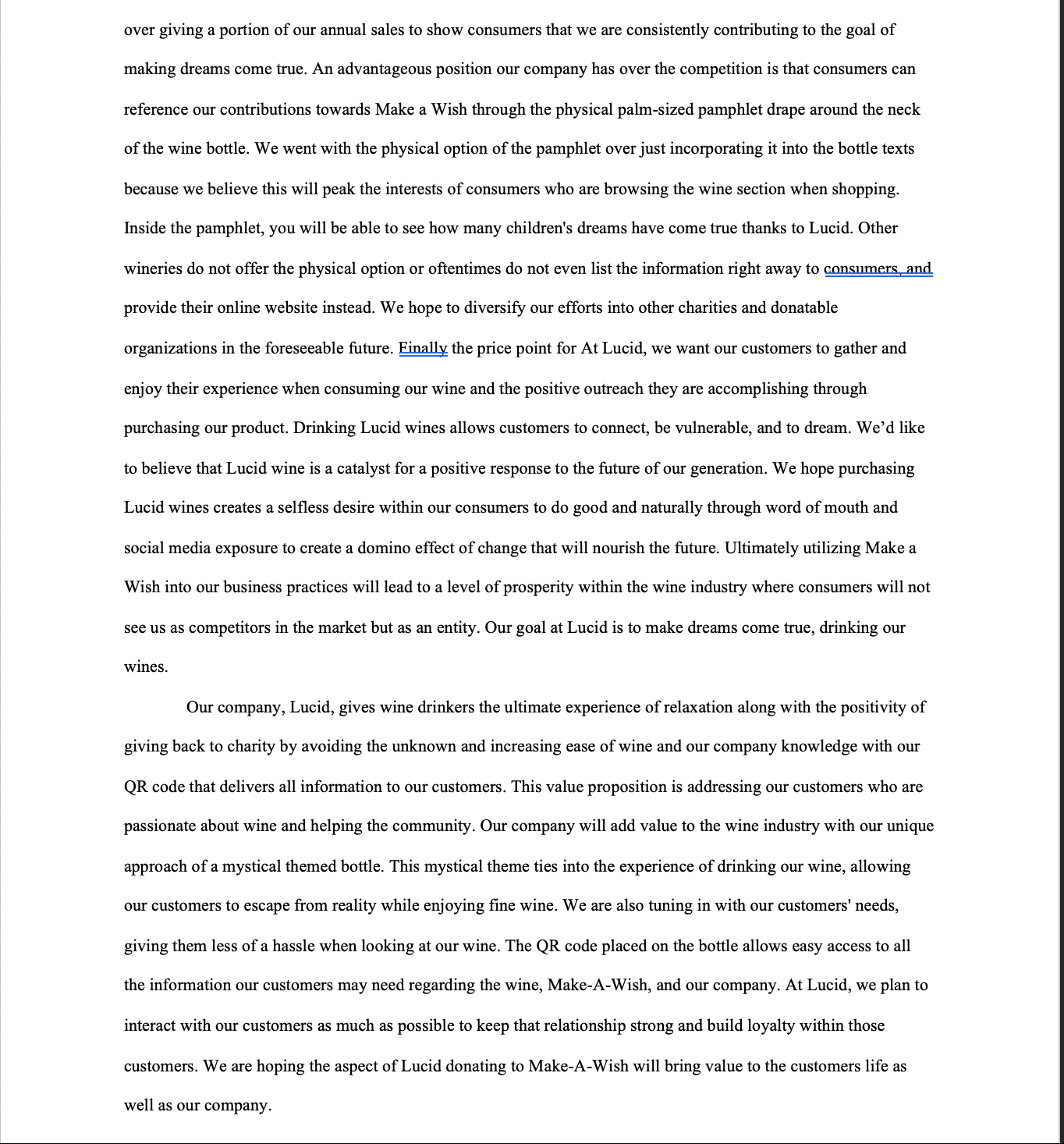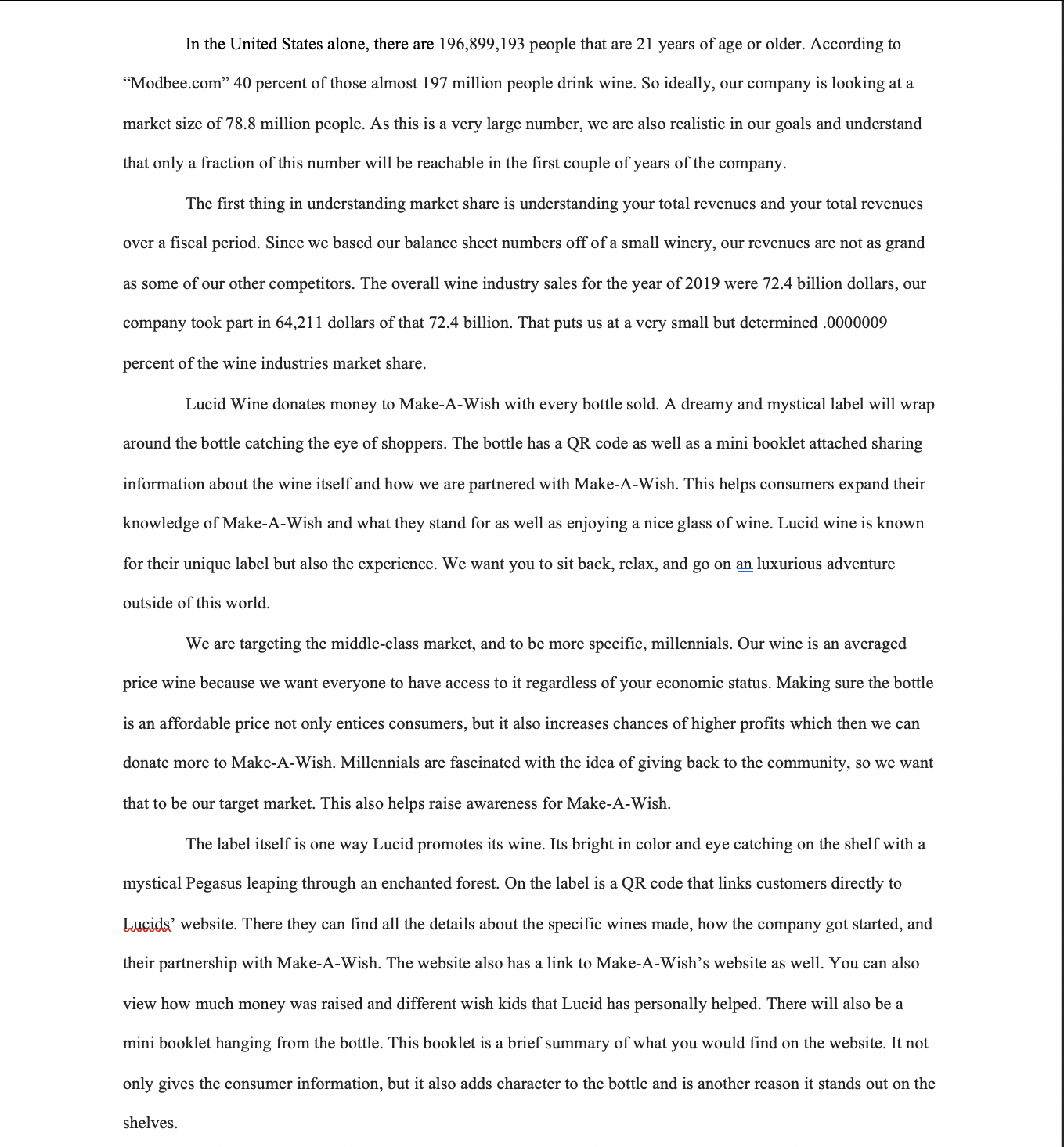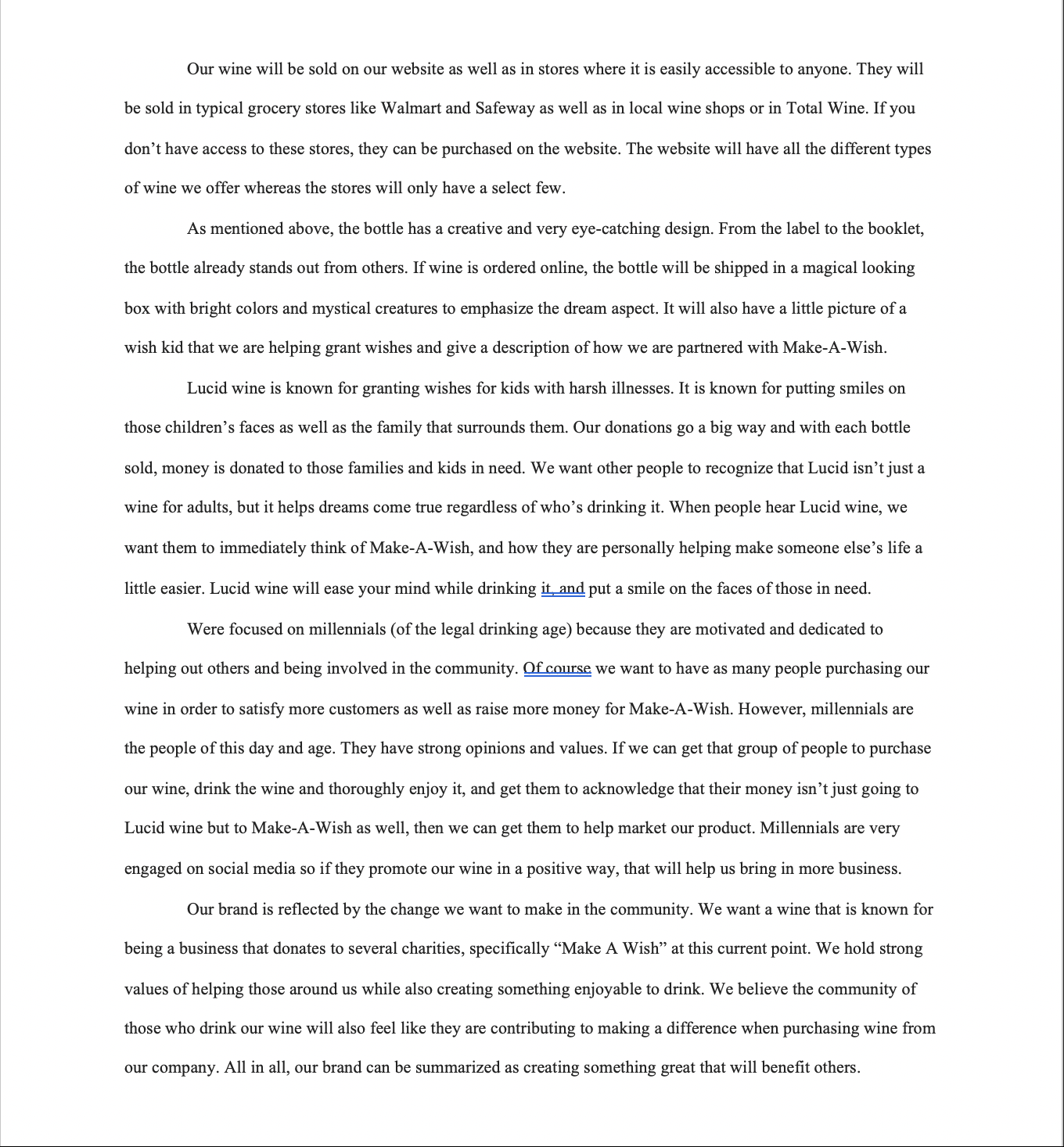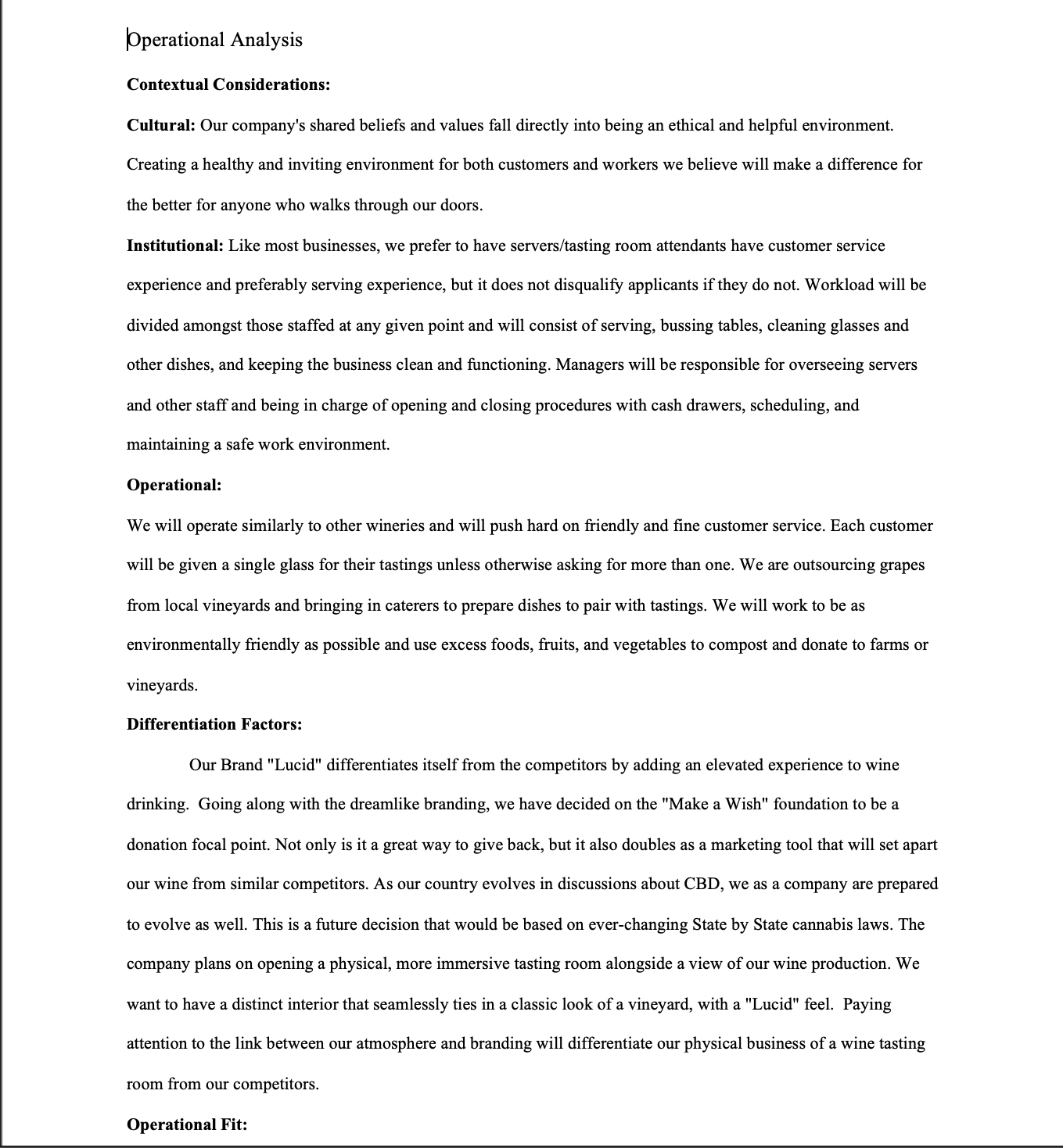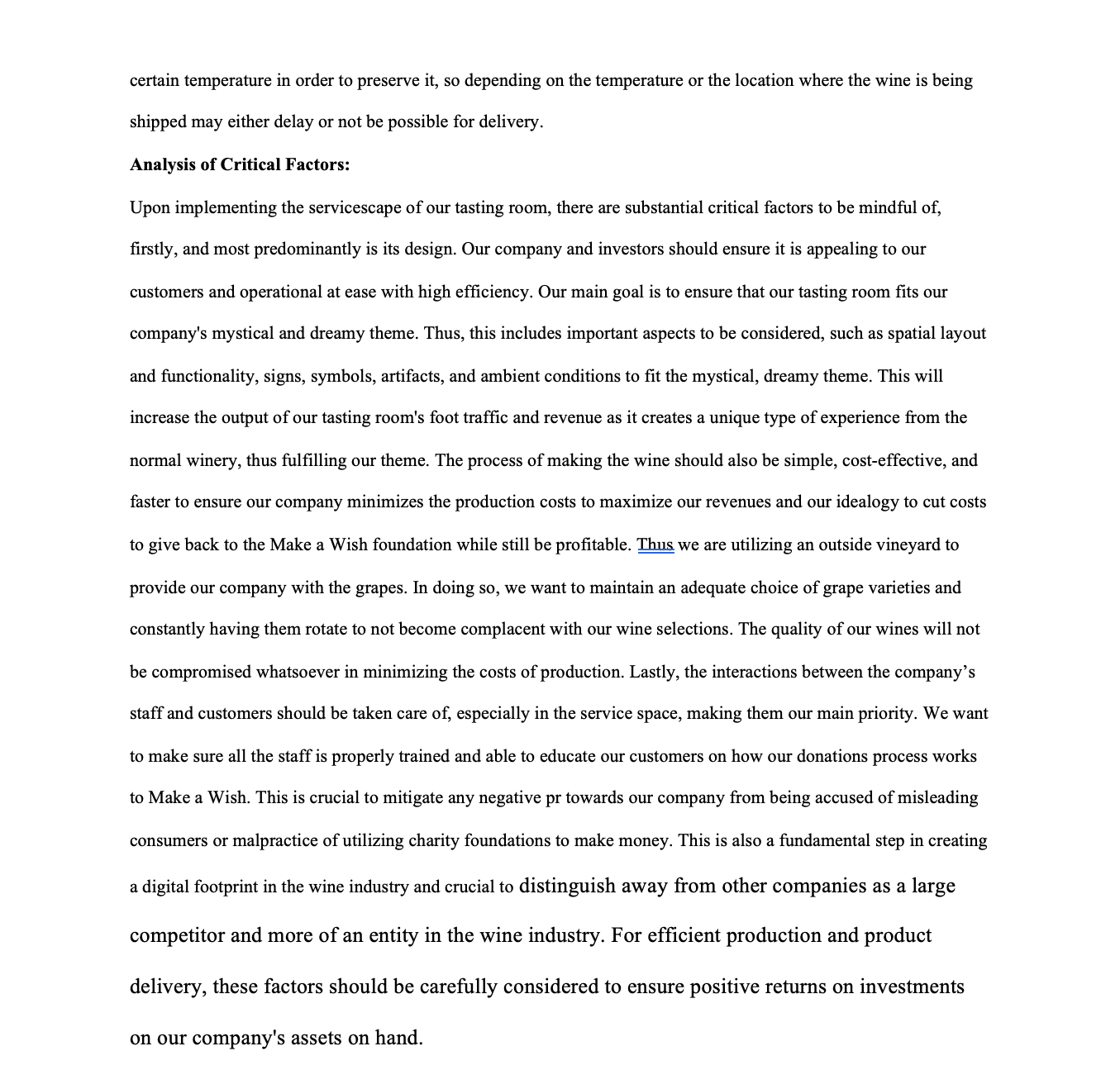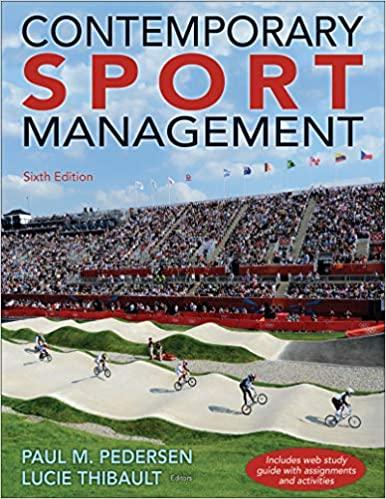Question: What are some ethical issues to consider upon implementing this wine company into the wine industry?
Data provided: The attachments provided below is the marketing and operational analysis I created of this fictional company.
Please do not respond with "incomplete question" or "Missing data, graph, link, or other material" because it is all provided.\
Our wine brand, Lucid, is a unique wine that supports children with illnesses, partnering with MakeA-Wish to donate to these children. We have a lot of opportunity to grow within the wine industry, as well as giving back to the community by donating to charity. Lucid plans to make a difference in the world while serving our customers a relaxing and delicious wine. Lucid will be utilizing both demographic and psychographic segmentation with moving forward in our business operations. We concluded that the majority of consumers of wine are Americans (Statista, 2020) and are located in metropolitan cities across the United States such as Seattle, San Francisco, Los Angeles, and New York City (W8: Schwing 2004). Therefore, the largest wine markets pertain to these cities, and Lucid is more likely to sell our wines in these markets. With the emphasis on doing good for our communities and children by providing a portion of our sales to Make a Wish foundation, we believe these Metropolitan cities that tend to carry more W consumers will favor our companies vision. We understand wine consumers have different needs, characteristics, behavior, and buying attitudes; this is when we want to incorporate demographic segmentation. With being awine company, our targeted audience can utilize awide spectrum, meaning we can have multiple targeted audiences such as Boomers, m millennials, and older generation Z. We aim to target these audiences utilizing information provided by WineBusiness.com and Dr. Liz Thach, distinguished professor wine, researcher and journalist where we saw the largest number of consumers of wines range from the ages of 24-60 (Thaeh, 2020). By targeting these demographics, we hope to utilize the largest amount of sales. Our company's positioning will be extremely advantageous over our competitors solely based on our niche in the marketplace. The only competition in the foreseeable iture, which has already established a digital footprint within this niche in the wine industry, WOuld be ONEHOPE. ONEHOPE donates to a wide variety of causes not solely proprietary to Make a Wish, thus making our focus towards this foundation even that more sought after/advantagecvus. Being a mythical themed Wine company, we concluded that Make a Wish Foundation would be ideal to t our business goals and objectives into distilling into consumers our Wsion. Although there are already established wineries that donate to charities, they do not include this into their everyday business model, such as our company is doing. They are ultimately donating at advantageous seasonality times for exposure to consumers such as Christmas or thanksgiving, which in essence, is a brilliant strategic move in the marketplace but is only temporary and can be ultimately seen as deceiving. We plan to donate 15% of each bottle's sales, a royalty if you may, to insinuate the more sales we make, the more we can contribute to Make a Wish. We chose this option over giving a portion of our annual sales to show consumers that we are consistently contributing to the goal of making dreams come true. An advantageous position our company has over the competition is that consumers can reference our contributions towards Make a Wish through the physical palm-sized pamphlet drape around the neck of the wine bottle. We went with the physical option of the pamphlet over just incorporating it into the bottle texts because we believe this will peak the interests of consumers who are browsing the wine section when shopping. Inside the pamphlet, you will be able to see how many children's dreams have come true thanks to Lucid. Other wineries do not offer the physical option or oentimes do not even list the information right away to W provide their online website instead. We hope to diversify cur efforts into other charities and donatable organizations in the foreseeable future. m the price point for At Lucid, we want our customers to gather and enjoy their experience when consuming our wine and the positive outreach they are accomplishing through purchasing our product. Drinking Lucid wines allows customers to connect, be vulnerable, and to dream. We'd like to believe that Lucid wine is a catalyst for a positive response to the future of our generation. We hope purchasing Lucid wines creates a seless desire within our consumers to do good and naturally through word of mouth and social media exposure to create a domino effect of change that will nourish the future. Ultimately utilizing Make a Wish into our business practices will lead to a level of prosperity within the wine industry where consumers will not see us as competitors in the market but as an entity. Our goal at Lucid is to make dreams come true, drinking our wines. Our company, Lucid, gives wine drinkers the ultimate experience of relaxation along with the positivity of giving back to charity by avoiding the unknown and increasing ease of wine and our company knowledge with our QR code that delivers all information to our customers. This value proposition is addressing our customers who are passionate about wine and helping the community. Our company will add value to the wine industry with our unique approach of a mystical themed bottle. This mystical theme ties into the experience of drinking our wine, allowing our customers to escape from reality while enjoying ne wine. We are also tuning in with our customers' needs, giving them less of a hassle when looking at our wine. The QR code placed on the bottle allows easy access to all the information our customers may need regarding the wine, Make-A-Wish, and our company. At Lucid, we plan to interact with our customers as much as possible to keep that relationship strong and build loyalty within those customers. We are hoping the aspect of Lucid donating to Make-A-Wish will bring value to the customers life as well as our company. In the United States alone, there are 196,899,193 people that are 21 years of age or older. According to \"Modbeecom\" 40 percent of those almost 197 million people drink wine. So ideally, our company is looking at a market size of 78.8 million people. As this is a very large number, we are also realistic in our goals and understand that only a fraction of this number will be reachable in the rst couple of years of the company. The first thing in understanding market share is understanding your total revenues and your total revenues over a scal period. Since we based cur balance sheet numbers off of a small winery, our revenues are not as grand as some of our other competitors. The overall wine industry sales for the year of 2019 were 72.4 billion dollars, our company took part in 64,211 dollars of that 72.4 billion. That puts us at a very small but determined .0000009 percent of the wine industries market share. Lucid Wine donates money to Make-A-Wish with every bottle sold. A dreamy and mystical label will wrap around the bottle catching the eye of shoppers. The bottle has a QR code as well as a mini booklet attached sharing information about the wine itself and how we are partnered with Make-A-Wish. This helps consumers expand their knowledge of Make-A-Wish and what they stand for as well as enjoying a nice glass of wine. Lucid wine is known for their unique label but also the experience. We want you to sit back, relax, and go on a_n luxurious adventure outside of this world. We are targeting the middle-class market, and to be more specic, millennials. Our wine is an averaged price wine because we want everyone to have access to it regardless of your economic status. Making sure the bottle is an affordable price not only entices consumers, but it also increases chances of higher prots which then we can donate more to Make-A-Wish. Millennials are fascinated with the idea of giving back to the community, so we want that to be our target market. This also helps raise awareness for Make-AWish. The label itself is one way Lucid promotes its wine. Its bright in color and eye catching on the shelf with a mystical Pegasus leaping through an enchanted forest. On the label is a QR code that links customers directly to M' website. There they can nd all the details about the specic wines made, how the company got started, and their partnership with Make-A-Wish. The website also has a link to Make-AWish's website as well. You can also view how much money was raised and different wish kids that Lucid has personally helped. There will also be a mini booklet hanging from the bottle. This booklet is a brief summary of what you would nd on the website. It not only gives the consumer infom'iation, but it also adds character to the bottle and is another reason it stands out on the shelves. Our wine will be sold on our website as well as in stores where it is easily accessible to anyone. They will be sold in typical grocery stores like Walmart and Safeway as well as in local wine shops or in Total Wine. If you don't have access to these stores, they can be purchased on the website. The website will have all the different types of wine we offer whereas the stores will only have a select few. As mentioned above, the bottle has a creative and very eye-catching design. From the label to the booklet, the bottle already stands out from others. If wine is ordered online, the bottle will be shipped in a magical looking hex with bright colors and mystical creatures to emphasize the dream aspect. It will also have a little picture of a wish kid that we are helping grant wishes and give a description of how we are partnered with Make-A-Wish. Lucid wine is known for granting wishes for kids with harsh illnesses. It is known for putting smiles on those children's faces as well as the family that surrounds them. Our donations go a big way and with each bottle sold, money is donated to those families and kids in need. We want other people to recognize that Lucid isn't just a wine for adults, but it helps dreams come true regardless of who's drinking it. When people hear Lucid wine, we want them to immediately think of Make-A-Wish, and how they are personally helping make someone else's life a little easier. Lucid wine will ease your mind while drinking w put a smile on the faces of those in need. Were focused on millennials (of the legal drinking age) because they are motivated and dedicated to helping out others and being involved in the community. Oicourse we want to have as many people purchasing our wine in order to satisfy more customers as well as raise more money for Make-AWish. However, millennials are the people of this day and age. They have strong opinions and values. If we can get that group of people to purchase our wine, drink the wine and thoroughly enjoy it, and get them to acknowledge that their money isn't just going to Lucid wine but to Make-A-Wish as well, then we can get them to help market our product. Millennials are very engaged on social media so if they promote our wine in a positive way, that will help us bring in more business. Our brand is reected by the change we want to make in the community. We want a wine that is known for being a business that donates to several charities, specifically \"Make A Wish" at this current point. We hold strong values of helping those around us while also creating something enjoyable to drink. We believe the community of those who drink our wine will also feel like they are contributing to making a difference when purchasing wine from our company. All in all, our brand can be Summarized as creating something great that will benet others. pperational Analysis Contextual Considerations: Cultural: Our company's shared beliefs and values fall directly into being an ethical and helpful environment. Creating a healthy and inviting environment for both customers and workers we believe will make a difference for the better for anyone who walks through our doors. Institutional: Like most businesses, we prefer to have servers/tasting room attendants have customer service experience and preferably serving experience, but it does not disqualify applicants if they do not. Workload will be divided amongst those staffed at any given point and will consist of serving, bussing tables, cleaning glasses and other dishes, and keeping the business clean and functioning. Managers will be responsible for overseeing servers and other staff and being in charge of opening and closing procedures with cash drawers, scheduling, and maintaining a safe work environment. Operational: We will operate similarly to other wineries and will push hard on iendly and ne customer service. Each customer will be given a single glass for their tastings unless otherwise asking for more than one. We are outsourcing grapes 'om local vineyards and bringing in caterers to prepare dishes to pair with tastings. We will work to be as environmentally friendly as possible and use excess foods, fruits, and vegetables to compost and donate to farms or vineyards. Differentiation Factors: Our Brand "Lucid" differentiates itself from the competitors by adding an elevated experience to wine drinking. Going along with the dreamlike branding, we have decided on the "Make a Wish" foundation to be a donation focal point. Not only is it a great way to give back, but it also doubles as a marketing tool that will set apart our wine from similar competitors. As our country evolves in discussions about CBD, we as a company are prepared to evolve as well. This is a future decision that would be based on ever-changing State by State cannabis laws. The company plans on opening a physical, more immersive tasting room alongside a view of our wine production. We want to have a distinct interior that seamlessly ties in a classic look of a vineyard, with a "Lucid" feel. Paying attention to the link between our atmosphere and branding will differentiate our physical business of a wine tasting room from our competitors. Operational Fit: At rst glance, a bottle of our Lucid wine will catch our customer's attention with mystical colors and designs. This idea is congruent with our company name, Lucid, and our brand. Our customers will be beneting children with illnesses, and those children's dreams are illustrated in our mystical designs. Our brand focuses on helping the community and children looking to make their dream come true through Make-AWish. When walking into our tasting room, our operational fit will again be congruent with our brand concept, including visuals that will be classy but still make customers feel relaxed and at peace, giving them more time to enjoy our delicious wine. We will have music playing at our tasting room, but at a very soft volume, to allow customers the opportunity to socialize or even talk with our employees about giving back to Make-AWish. Supplier, Outsourcing, and Availability Issues: Lucid wine uses an outside Supplier to receive grapes to produce the wine. We don't grow our own grapes or have our own vineyard. Lucid gets their grapes from Red Mountain AVA, near Columbia and Yakima Valley. Using the method of outsourcing from a supplier saves money by not having to maintain and own a personal vineyard. An isSue with this is that Lucid doesn't have as free of access to the grapes that we could if we owned our own vineyard. We would have to coordinate with the supplier before every encounter with or on the vineyard. Lucid's tasting room will be located in Tri-Cities, Washington. This is close in location to the actual vineyard, making it easy to transport the grapes from the vineyard to the tasting room where the wine is physically made. The vineyard is easily accessible, which is important for observing the vines' growth and keeping a lookout for certain varictals. It can also make the harvesting process faster because we don't have to spend a whole day driving to the vineyard to retrieve the grapes and can use that time to crush them. Lucid also uses outside suppliers for the equipment needed to make and store the wine. For example, oak barrels, fermentation tools, and additives, and any type of machinery. The tasting room will be set up where you can see the barrels while enjoying the wine. At certain times you can watch the winemakers in the back while they make the wine. The tasting room will be somewhat divided from the area where the wine is made, but both will be at the same location and in the same building. The only thing not at the tasting room will be the vineyard. However, there will be information and photos inside the tasting room about the vineyard, its location, climate, and varietals that we ownfbuy. Lucid will ship bottles of wine to local stores as well as stores across Washington State. This also includes online orders. Shipping wine is somewhat difth however, as the glass can break easily, so they need to be transported safely and properly to prevent this. Wine needs to stay at a certain temperature in order to preserve it, so depending on the temperature or the location where the wine is being shipped may either delay or not be possible for delivery. Analysis of Critical Factors: Upon implementing the servicescape of our tasting room, there are substantial critical factors to be mindful of, rstly, and most predominantly is its design. Our company and investors should ensure it is appealing to our customers and operational at ease with high efciency. Our main goal is to ensure that our tasting room ts our company's mystical and dreamy theme. Thus, this includes important aspects to be considered, such as spatial layout and functionality, signs, symbols, artifacts, and ambient conditions to fit the mystical, dreamy theme. This will increase the output of our tasting room's foot trafc and revenue as it creates a unique type of experience from the normal winery, thus fullling our theme. The process of making the wine should also be simple, cost-effective, and faster to ensure our company minimizes the production costs to maximize our revenues and our idealogy to cut costs to give back to the Make a Wish foundation while still be protable. % we are utilizing an outside vineyard to provide our company with the grapes. In doing so, we want to maintain an adequate choice of grape varieties and constantly having them rotate to not become complacent with our wine selections. The quality of our wines will not be compromised whatsoever in minimizing the costs of production. Lastly, the interactions between the company's staff and customers should be taken care of, especially in the service space, making them our main priority. We want to make sure all the staff is properly trained and able to educate our customers on how our donations process works to Make a Wish. This is crucial to mitigate any negative pr towards our company from being accused of misleading consumers or malpractice of utilizing charity foundations to make money. This is also a fundamental step in creating a digital footprint in the wine industry and crucial to distinguish away from other companies as a large competitor and more of an entity in the wine industry. For efcient production and product delivery, these factors should be carefully considered to ensure positive returns on investments on our company's assets on hand
